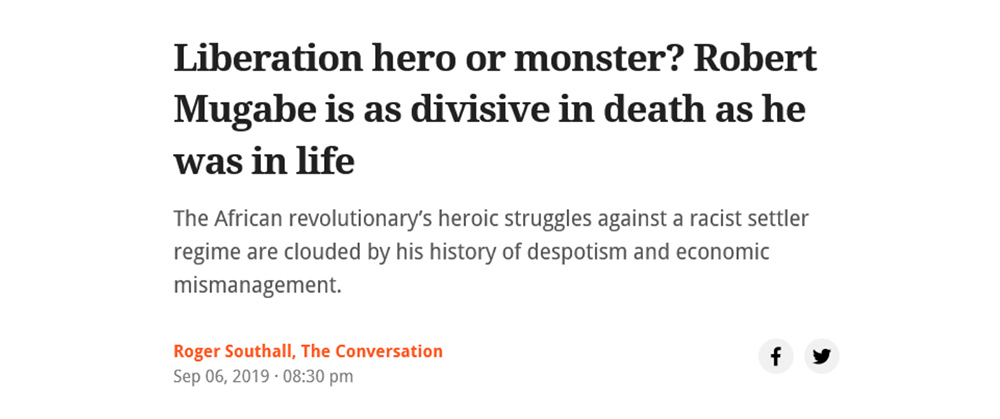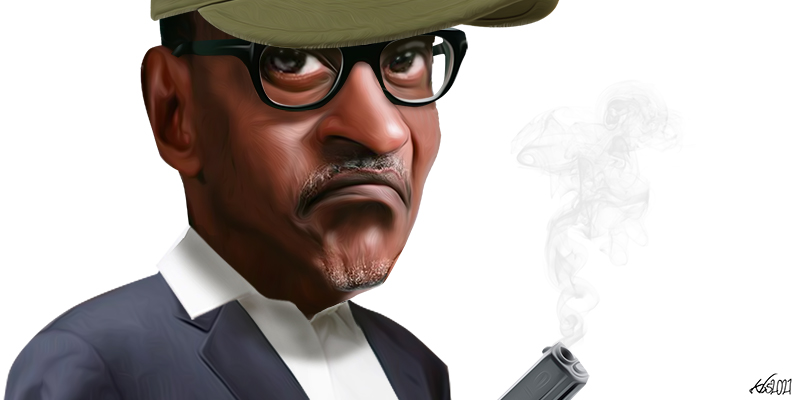There is a new book out on Rwanda that, for various reasons, has made quite some “waves”: Michela Wrong’s Do not disturb: The Story of a Political Murder and an African Regime Gone Bad (published end of March 2021). It is about a controversial topic: the politics of the government of Rwanda, the Rwandan Patriotic Front (RPF), and President Paul Kagame. The book blurb reads:
Do Not Disturb is a dramatic recasting of the modern history of Africa’s Great Lakes region, an area blighted by the greatest genocide of the twentieth century. This bold retelling, vividly sourced by direct testimony from key participants, tears up the traditional script. The new version examines afresh questions which dog the recent past: Why do so many ex-rebels scoff at official explanations of who fired the missile that killed the presidents of Rwanda and Burundi? Why didn’t the mass killings end when the rebels took control? Why did those same rebels, victory secured, turn so ruthlessly on one another? Michela Wrong uses the story of Patrick Karegeya, once Rwanda’s head of external intelligence and a quicksilver operator of supple charm, to paint the portrait of a modern African dictatorship created in the chilling likeness of Paul Kagame, the president who sanctioned his former friend’s murder.
Wrong also published a Guardian opinion piece a few days ago that begins as follows:
There are moments when the international community’s perception of a leader shifts into a new configuration, often for reasons that can’t be entirely logically explained. Myanmar’s Aung San Sui Kyi reached that tipping point during the Rohingya crisis, Ethiopia’s prime minister, Abiy Ahmed, has been undergoing the same transition since war broke out in Tigray, and the same process is taking place with the Rwandan president, Paul Kagame. Today, he is welcoming the French president, Emmanuel Macron, to Kigali, his spotlessly tidy hillside capital. . .
The piece closes with:
In February, Rwandan officials attending the Universal Periodic Review in Geneva seemed taken aback by the bluntness of the human rights concerns aired by US and UK delegates. Kagame was not included among the five African presidents invited to Biden’s climate summit in April, and Rwanda was bypassed on Secretary of State Anthony Blinken’s virtual visit to Africa. A lot of this recalibration can be explained by the sheer passage of time. Kagame has now been at the helm for 27 years, and such longevity carries its own message. As one development official told me: “Anyone who is in power that long, well, you have to regard them as a dictator, don’t you?”
Like her book on corruption in Kenya, Our Turn to Eat, published back in 2009, Wrong’s new book has been received with enthusiasm in the UK and US. Various high-end webinar and podcast book launches have already been held in, among other places, the UK, the US and South Africa, with, for example, the Royal African Society/SOAS, the Foreign Press Association USA, the South African Institute of International Affairs, or Public Affairs Books (see also for other launch talks here, here, here, here, here, here and here; further reviews and launches are publicised at fast speed). The book was much praised by various launch hosts and speakers. On one event page one can read: “Near the end of this episode, host of the Departures podcast Robert Amsterdam tells his guest, ‘This is perhaps the best book I’ve ever read on Africa, and I’ve read a lot of books.’ Such is the esteem we hold for Michela Wrong.”

And one can find headlines like this Reuters one in the ongoing launch phase of the book.

So, there is great interest in the book. The cover carries praises by John Le Carré who assesses the book to be “A withering assault on the murderous Rwandan regime of Paul Kagame – very driven, very impassionate”, and, according to the longer review available online, “a melancholy love song to the last dreams of the African Great Lakes”. Archbishop Desmond Tutu evaluates the text to be an “extremely important and profoundly disturbing book”. More appraisals are listed here with the Rwandan government being described as a “murderous” and “profoundly criminal regime”, and Kagame as a “ruthless dictator”.
Further, Edward Clay, who was the UK’s Ambassador to Rwanda from 1994 to 1996, the British High Commissioner in Uganda from 1993 to 1997 and in Kenya from 2001 to 2005, writes in the last paragraph of his review: “Wrong concludes with reminders of why her book’s title is apt. The heroic days of the RPF have yielded to duplicity, treachery, betrayal and assassination. Why did those who later fell out with the regime serve so long as its defenders, apologists and executives; and why is the obscure Kagame of 1990 still standing tall thirty years on?” Finally, at a book launch hosted by Ian Williams, President of the Foreign Press Association USA, he asks Wrong towards the end of their talk: “Is there hope, is Kagame going to appear before the International tribunal?” Clay’s book review was published on DemocracyinAfrica.org and assessed to be a “great read” by scholar Nic Cheeseman, the website’s founder. Cheeseman also expressed in a tweet: “Can’t wait to hear Michela Wrong talk about her new hard hitting book on Rwanda”. (bold in original). Do not Disturb was the website’s “Book of the Month” earlier this year.
Great read! Edward Clay, former UK High Commissioner to Uganda and Kenya, reviews Michela Wrong's new book on Rwanda, Do Not Disturb. The latest in the excellent #BookClub series over at @AfricaDemocracy. Check it out now. @michelawrong #DoNotDisturb https://t.co/xyxutTklMJ
— Nic Cheeseman (@Fromagehomme) March 23, 2021
Can't wait to hear Michela Wrong talk about her new hard hitting book on Rwanda – Do Not Disturb – on the next Resistance Bureau show on Tuesday 9 March. Join us to hear its key messages. @michelawrong @public_affairs #Rwanda #Kagame
Register Here: https://t.co/r7UqK2ABIz https://t.co/zx0kVhcGVv
— Nic Cheeseman (@Fromagehomme) March 4, 2021
The book has received criticisms too and they include charges of naivety, one-sidedness, partisanship, propaganda, demonisation/character assassination of Kagame, revisionism, and racism (see e.g. here, here, here and here). In the first part of his three-part review, Ugandan analyst and journalist Andrew Mwenda writes that Wrong’s book continues with a line of analysis that pathologises African political actors. The matter here is state violence (particularly extra-territorial killings). Mwenda argues that this political phenomenon needs to be analysed as a matter of foreign policy choices (and, generally, political repertoire) not as a psychological/cultural phenomenon. Mwenda further argues that these practices are analysed, interpreted and judged differently by many Western scholars, depending on whether the protagonists are Western or African leaders:
Many countries have always acted extra-territorially depending on their judgement of the nature of the threats they faced. During the cold war, the Americans, French, British, and Russians intervened in other countries using coups, civil wars, and targeted assassinations. The Americans attempted to assassinate Castro 76 times yet he never sought to attack the USA, just to be independent of it. After 9/11, the America government adopted a policy of preemptive war to any threat anywhere. The American state has carried out coups, assassinations or sponsored civil wars and terrorist activities in Iraq, Syria, El Salvador, Guatemala, Cambodia, Angola, Mozambique, Afghanistan, Pakistan, Grenada, Vietnam, Libya, etc. Would Wrong accuse any U.S. president of being a violent psychopath?
This is the problem I have with many Western scholars, journalists and diplomats. When something is done by their countries, they focus on the national policy that informs the decision, not the personality of the leader who made it. They can criticise the policy but rarely do they attribute it to some mental or psychological pathology of the leader. When the same thing is done by an African leader, they ignore the circumstances that informed such a decision and accuse the individual leader of madness or psychopathy. I hate to use the word racism. But if this is not racism, what is it? Wrong . . . presents such policy [Rwanda’s extraterritorial operations] as the product of . . . Kagame’s psychopathy.
Mwenda here opens up the question of comparison about political violence in general and state violence (and state crimes) in particular: how does the Rwandan case of (especially extraterritorial) state violence compare globally — and particularly vis-à-vis Western states such as the US — on a continuum of “degrees” of state violence abroad?
The racism charge in the debate emerges, amongst others, due to the opening chapter of Wrong’s book, which she has reproduced on the Lit Hub website. It has been commented on, in particular by Mwenda (see also e.g. here) and reads as follows:
Rwandans kept telling me that deceiving others, being economical with the truth, was something their community reveled in, positively prided itself upon. Especially when dealing with Western outsiders. A proof of superiority, not shame, when successfully achieved. So much so, that the practice had worked itself into the language. . . . One of Rwanda’s prime ministers, Agathe Uwilingiyimana, shocked the head of a UN peacekeeping force by telling him: “Rwandans are liars and it is a part of their culture. From childhood they are taught to not tell the truth, especially if it can hurt them.”. . . A successor told me the same thing over coffee in a Brussels hotel lobby many years later: “In Rwanda, lying is an art form. When you, as a white journalist, leave a meeting, they will be congratulating themselves: ‘We took her for a ride.’ Lying is the rule, rather than the exception.” It was an accusation tossed into conversations with Tutsis and Hutus, Rwandans and Ugandans, diplomats and military men, lawyers, and journalists. “You spoke to so-and-so? Oh, he’s the most terrible liar.”
Wrong details some of her views regarding political violence/culture in the case she takes into focus in a talk here (e.g. min 8:57 onwards, and especially min 17:52 onwards), and also offers a comparative commentary regarding Rwanda vs the West/US here (min 4:33 onwards). Wrong reacts to the criticism concerning the points about “lying . . . as part of Rwandan culture” and “culture of deceit” in a book launch event in June hosted by Lindsey Hilsum, International Editor, Channel 4 News (see min 16:19 onwards).
The Royal African Society which co-hosted a book launch back in April received a petition titled “Show that racism has no place at the Royal African Society”. Signed by 1099 people, it notes:
We are shocked to see that the Royal African Society are providing a platform to Michela Wrong. Ms Wrong has a history of using racist and offensive language when discussing the African continent and its people. Wrong’s most recent work, Do Not Disturb, is saturated with offensive stereotypes and underpinned by her argument that in Rwanda, everyone is a liar. In her introduction, she writes about Rwandans: “Deceiving others was something their community revelled in” and “In Rwanda, lying is an art form”. These are long-established tropes which were used in the past to demonise Tutsis. One of the architects of the genocide, Theoneste Bagosora, in his 30-page booklet inciting hatred towards the Tutsi said: “The Tutsis are the masters of deceit” and “Inveterate liars”. Wrong also quotes Ewart Grogan. Grogan, who Wrong refers to as an ‘Adventurer’, was in fact a colonialist who worked for Cecil Rhodes and was convicted for beating Africans in the street. She makes no mention of this, or the fact that Grogan said that in fact all Africans are “fundamentally inferior”, choosing instead to select his quote: “Of all the liars in Africa, I believe the people of Ruanda are by far the most thorough” to support her contention that Rwandans could not be trusted. The neo-colonial undertones to her work are barely concealed.
This is not the first time that Wrong has used outdated, offensive, and unnecessarily graphic language when discussing the continent. In one of Wrong’s previous works, In the Footsteps of Mr Kurtz, she said: “Africa, a continent that has never disappointed in its capacity to disappoint: Hutu mothers killing their children by Tutsi fathers in Rwanda; the self-styled Emperor Bokassa ordering his cook to serve up his victims’ bodies in Central African Republic; Liberia’s rebels gleefully videotaping the torture of a former president”. In the same book, Wrong stated that: “There were more recent signs that La Sape was being infected by the ‘slob’ look embraced by America’s blacks, all outsized jeans, baggy dungarees and shorts that drop to calf level”. At other points, she paints a picture of Rwandans as a people conditioned to kill from birth. When describing a typical Rwandan “peasant”, she suggests that “If instructed to kill you, he may well pick up a machete, because the value of obedience has been impressed on him since birth and, above all, no one wants to stand out from the crowd”. Her contempt for Rwandans, who in her mind are all one and the same, is plain to see.
We are shocked that in 2021, and in the era where racism and discrimination in all its forms is being challenged around the world, these views are published and promoted without challenge. . . . We call on the Royal African Society to immediately review their decision to provide Ms Wrong a platform and commit to challenging her racist and offensive views about Rwandans and Africans more widely.
The written reply of the Society’s Director, Nicholas Westcott, to the petitioners includes these lines (emailed to us by Westcott with permission to publish):
We are very conscious of the sensitivity of many issues in Rwanda’s history, and especially the question of the genocide. I have read Ms Wrong’s book (and indeed her previous books), and I feel your selective quotations distort her message and misrepresent her views. There is certainly criticism of the current government, but not in a form that can justifiably be described as racist. The meeting we are holding to discuss her book is open to the public, so those who disagree with Ms Wrong’s views are welcome to participate and express their own opinion, raise questions or explain their disagreements. . . .
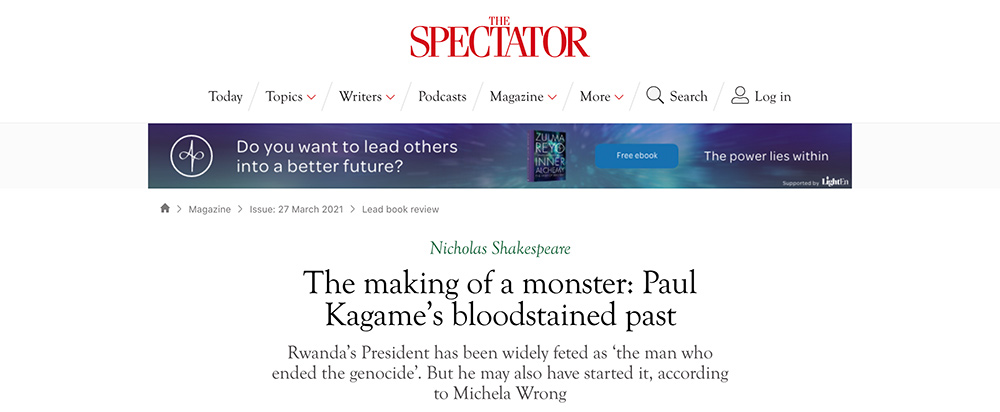
We do not provide a review of the book. Rather we wish to problematise two headlines of the book reviews in the UK press — in the Times and the Spectator. In the review title there is reference to Kagame as a “monster”. The titles read: “Do Not Disturb by Michela Wrong review — the making of a monster” and “The making of a monster: Paul Kagame’s bloodstained past”. The pieces are written by high-profile writers Ian Birrell and Nicholas Shakespeare. Birrell also uses the “monster” characterisation in a tweet about the piece and, in the review, employs the “savagery” term in this passage: “She exposes a more complex and tawdry story, showing the savagery that lies below the smooth surface of a regime hailed by many Western admirers.” and writes that “this gruesome regime . . . lies blatantly on everything . . . .”
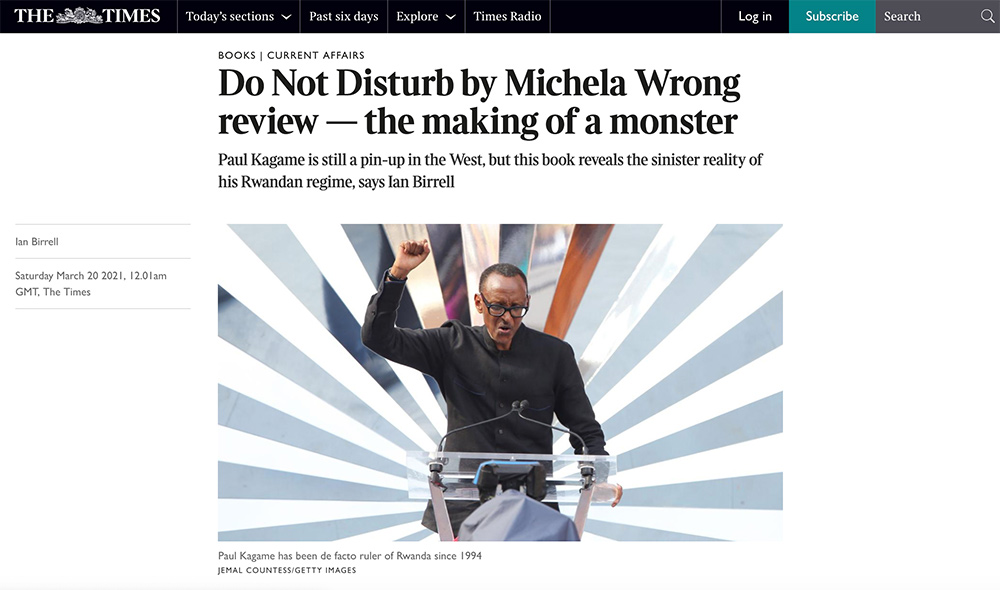
Birrell’s text reads:
Yet this interwoven story of two fascinating men is much more than a smart device to tell the tale of another African rebel leader who festered in power, even if it is a riveting account of raw power turned rancid. Wrong, the author of fine books on Eritrea, Kenya and the Congo, challenges the tatty conventional narrative on the 1994 genocide, with its simplistic notion of triumphant Tutsi good guys led by the heroic national saviour returning from exile. She exposes a more complex and tawdry story, showing the savagery that lies below the smooth surface of a regime hailed by many Western admirers.
The pages are laced with irony since Karegeya was a key player in creating the deceptive façade of a democratic Rwanda, before he fled and rebranded himself as an opposition leader. “When they say these dictators and monsters are created by those around them, I think it’s true,” confesses another key figure in exile. “We had a hand in the making of a monster.”
The making of a monster – my @thetimes review of @michelawrong’s superb new dissection of Kagame’s bloodstained regime in Rwandahttps://t.co/fv8mjADNnR
— Ian Birrell (@ianbirrell) March 20, 2021
The book offers searing indictment of naive western politicians and gullible aid groups that appease this gruesome regime in desperation to find a poster child for their policies of spraying cash around the planet, ignoring how it lies blatantly on everything from human rights to poverty data. Wrong also points to the racism that lurks behind the idea Africans need a strongman to keep them in order.
We do not know whether the authors or editors of the book reviews came up with the “monster” titles. In any case we find the “monster” headline disturbing (though not surprising given the racism in part of the UK press) and worth analytical attention. We look in particular at sections of the press and non-academic writing but arguably, the issue is wider and deeper. We have for various reasons become interested by the reception of the book in the press — and in academic and policy circles generally — in the past week, one of the reasons being that this reception is deeply political at various levels. They are “events” (and thus insightful “data”) in the unfolding politics of Do not Disturb. What is discussed and judged (and reframed) there is arguably not just Rwanda, Kagame and the RPF. The book and the fast-mounting debate relate to wider political issues and discourses: representations of Africa; media; Western imperialism, foreign policy and aid; the West’s self-image; North-South relations; Africa rising; African statehood/sovereignty; political violence; knowledge production; the relationship between scholarship/academia/media/experts and foreign policy, for example in the UK and US, and the silences, taboos and no-goes in part of Western scholarship, media commentary and reporting, particularly about state/political violence (or in Wrong’s terms “political murder”) of Western imperialist countries (i.e. the Western empire). Wrong’s writing speaks to some of these foreign policy/international relations issues and the reviews and headlines pick it up (“the world” ignores/wakes up, etc.). Our theme of interest is thus also how Western media, academia and expert circles do politics and the respective authors’ relationship with the foreign policies of their governments (in this case vis-à-vis African countries and governments). We realise that this is a theme that has a long history, but we think it deserves renewed attention as the geopolitical and inter-imperialist conflicts once again intensify, and as the media landscape changes in a very particular way.
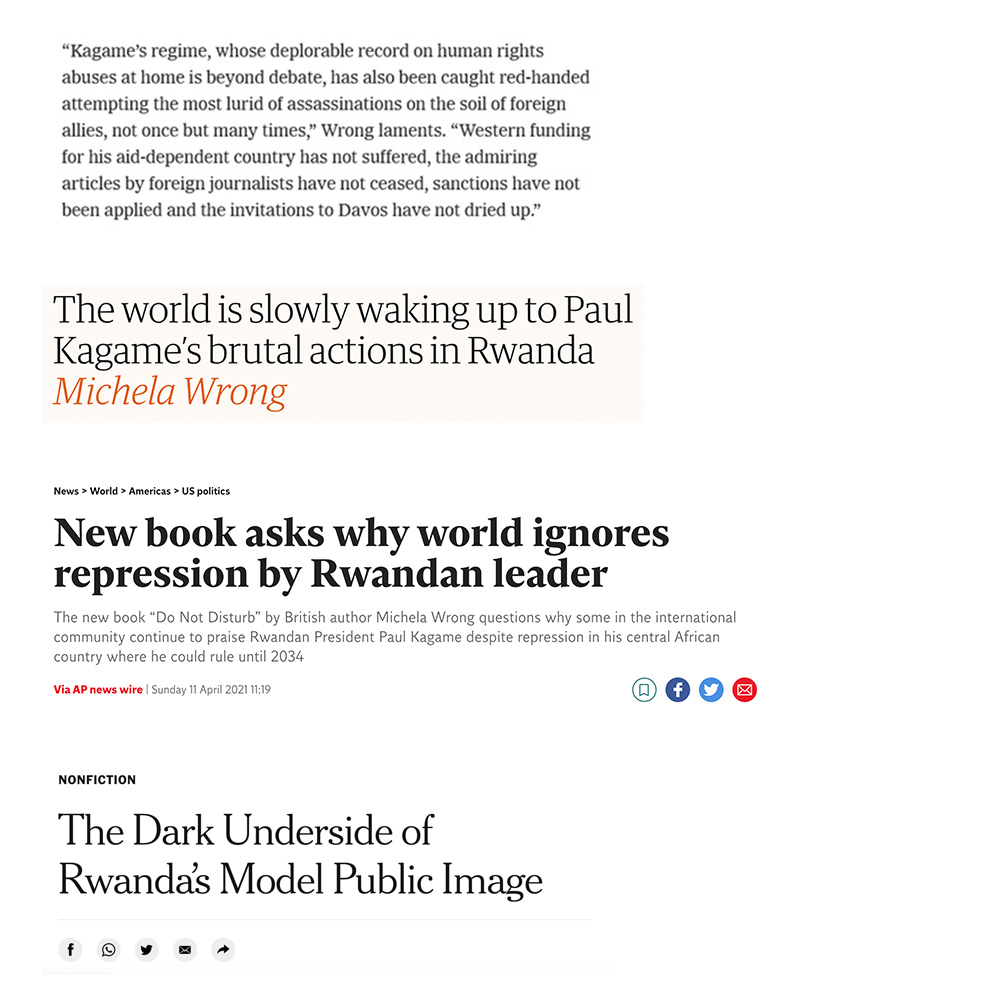
Notably, Kagame is not the first post-independence leader from the continent to be characterised as a monster by the Western media in prominently displayed headlines and/or article-summary lines. Instead, he is the latest in a longer list of “monsters” that goes far back in history. We found monster-calling with regard to leaders ranging from Idi Amin, Muammar Gaddafi, Charles Taylor (see also here re. Chucky Taylor), and Robert Gabriel Mugabe, with many in-between. Mugabe: Monster or Hero? one France24 headline reads. Robert Mugabe: Hero and Monster, titles a Canadian outlet. And the UK’s Telegraph used the monster characterisation for years in some of the Mugabe headlines. Just a few months ago, The Times referred to Amin as a monster in the summary line of a review of the new book by Mark Leopold: Idi Amin: The Story of Africa’s Icon of Evil (for a review see here). Joseph Kony has received monster headlines too, e.g. in The Sun, and in an in-text passage in an Observer report about the documentary film Kony 2012. See also a book titled Dancing in the Glory of Monsters: The Collapse of the Congo and the Great War of Africa, by Jason K. Stearns. Amin, Gaddafi and Mobutu (and Jean-Bédel Bokassa) also made it onto the list of “monsters” in a book titled Children of Monsters: An Inquiry into the Sons and Daughters of Dictators, by Jay Nordlinger.
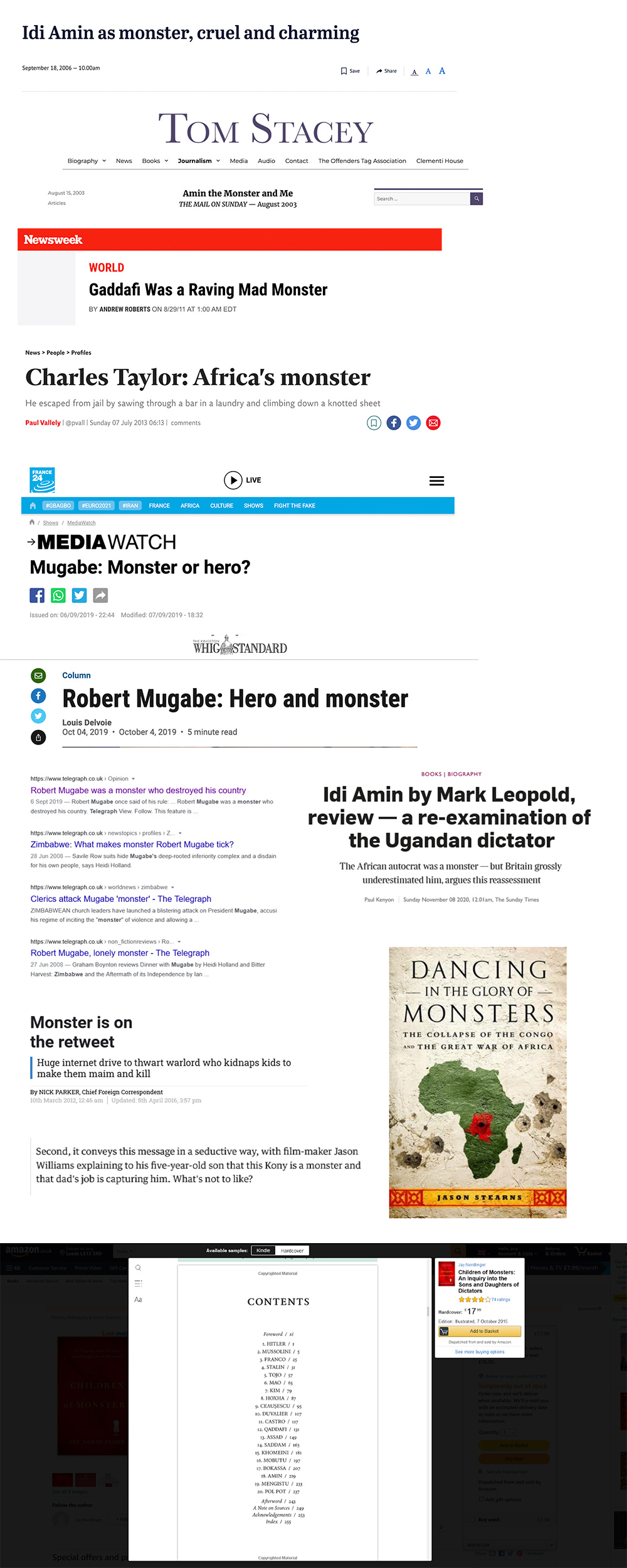 It is against this background that we want to make very few basic points about “the West” and its apparent African Monsters syndrome. We want to start by posing some questions (while leaving them largely open for debate): why have some Western press outlets, throughout the decades, referred to some leaders in Africa (but also in other regions such as Latin America) as monsters? Why do these outlets — and their respective writers and editors — mobilise the “monster” characterisation when they write about other countries’ leaders that a part of “the West” (i.e. sections of political actors, commentators, etc.) views, for whatever reasons, in a critical light? And what might be the commonality between those leaders from around the globe who make it into the infamous box of “monsters”? What are the mechanisms that produce the monster category in politics? Why have some African political leaders that are eventually labelled “monsters” often been labelled “heroes” first (Kagame and Mugabe for example)? What has changed in the politics of these cases that informs the change in narrative, image and label? The discourse we bring into focus is generated in countries with intense geopolitical interests in African countries and so matters of narrative politics and control come in. It is a ubiquitous US, UK and Western European formation that we have in mind when we refer to “the West’.
It is against this background that we want to make very few basic points about “the West” and its apparent African Monsters syndrome. We want to start by posing some questions (while leaving them largely open for debate): why have some Western press outlets, throughout the decades, referred to some leaders in Africa (but also in other regions such as Latin America) as monsters? Why do these outlets — and their respective writers and editors — mobilise the “monster” characterisation when they write about other countries’ leaders that a part of “the West” (i.e. sections of political actors, commentators, etc.) views, for whatever reasons, in a critical light? And what might be the commonality between those leaders from around the globe who make it into the infamous box of “monsters”? What are the mechanisms that produce the monster category in politics? Why have some African political leaders that are eventually labelled “monsters” often been labelled “heroes” first (Kagame and Mugabe for example)? What has changed in the politics of these cases that informs the change in narrative, image and label? The discourse we bring into focus is generated in countries with intense geopolitical interests in African countries and so matters of narrative politics and control come in. It is a ubiquitous US, UK and Western European formation that we have in mind when we refer to “the West’.
In any case we find the “monster” headline disturbing (though not surprising given the racism in part of the UK press).
Before we start: yes, there are also headlines that refer to former US president Trump as a monster (e.g. here or here, and he was called monster by an official; see also here re. George W. Bush; and here or here for Barack Obama, or for Jair Bolsonaro, here and here). And the characterisation is not used just by “right-wing” outlets. But, arguably, overall these are somewhat different cases, in different contexts. One may debate in future what the commonality and connection is in these global “monster” cases, across these regions. What explains the choices of the editors and writers? The immediate question at hand, however, might rather be: do the Times/Spectator editors who run the Kagame-monster-headlines refer to some Western leaders as monsters too, or do they only use the characterisations in texts about non-Western leaders? Our focus of analysis is the West and its African “monsters-in-government”, i.e. the reporting, analysing and headlining about leaders from the continent (and by extension in the Third World/Global South; Fidel Castro and Nicolas Maduro, for example, have also had their share of “monster” headlines).
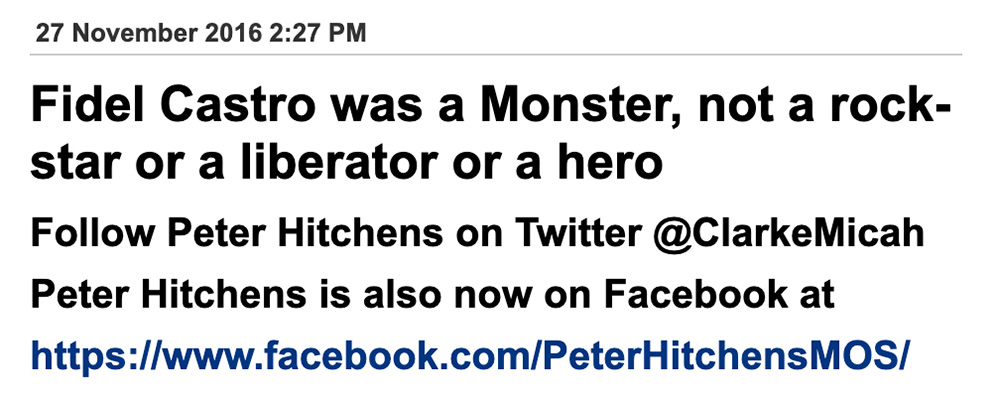
The “hero or . . .” binary also features here (and the question is why we repeatedly find these binaries in such headlines).

That said, let’s examine one relatively recent case of the West’s African Monsters syndrome: Zimbabwe’s former president Robert Gabriel Mugabe, now deceased. For years, Mugabe — who was at one time happy to implement the policies of the IMF and World Bank — was transformed into the despised tyrant of the continent, a “monster” determined to unleash “mob savagery” against law abiding (white) Zimbabweans (The Daily Telegraph, 10 August 2001).
In the early 2000s, TV programmes and newspaper articles were full of the “catastrophe” for white Zimbabwe, and Mugabe was labelled the killer-in-chief – a man who once knew his place, he was quickly transformed over a period of a couple of years from 1999 to 2001 into the very embodiment of the continent’s monsters.
For the next twenty years and until he died on 6 September 2019, coverage in the media and popular history books were unanimous about Mugabe’s role in Zimbabwe’s plunge. The devastation to white farmers in the country, with hysterical war veterans or “mobs” rampaging mindlessly through the capital, Harare, had a single cause: Mugabe’s megalomania and an insatiable craving for power. Many “serious” studies were dragged into the metanarrative. Dinner with Mugabe by Heidi Holland, published in 2009, told the story of a “freedom fighter” who became a “tyrant”. Even reviews of the balanced account of Zimbabwe’s crisis by Richard Bourne, Catastrophe, which came out in 2011, were replete with praise for charting Mugabe’s lunacy. At the time, the BBC’s James Robbins explained how the book “expertly lays bare Mugabe’s terrifying abuse of power — his path from liberator to destroyer — as well as charting the failures by Britain and the world to challenge him effectively.”
Across the US and UK, some commentators, academics and politicians referred to Mugabe as a madman “on the loose”, and spoke of a crisis “driven by one man’s ruthless campaign”. In the West’s wild imaginings, Zimbabwe became a symbol of the need to reorder Africa. When Mugabe was metamorphosing into a monster of continental proportions in the early part of the century, the then UK Foreign Secretary, Jack Straw (of the Labour party), insisted that it was “our” responsibility not to “let a great continent go down”.
By the end of the first decade of this century, Amazon was listing seven biographies of Mugabe written in the previous few years. Each, in a different way, promised to get to the “man behind the monster”. Today on Amazon’s site, the list of Mugabe “monster biographies” is literally endless — an industry has grown up around this popular imaginary that defies even our wildest exaggerations.
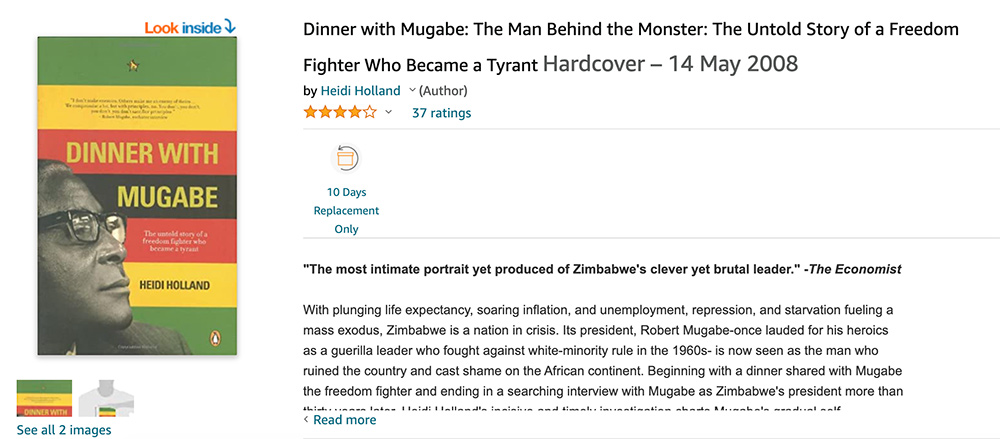
Why does it matter? The core of our argument is not knee-jerk support for political figures on the continent demonised by the monster characterisation. Instead, we see the terms used in headlines of reviews of Wrong’s book, and others, as a default racism — apparently still so deeply embedded in the minds of the respective writers/editors that they are unable to see how they simply slot into popular and racists assumptions about Africa and its people. The language, tools and analyses of these commentators are unreformed and colonial in origin. The monster characterisation dehumanises African leaders, and arguably their families, communities and societies too.
There is another dimension to it which we can only sketch out in brief here, but hope it can be further debated by others in future. It links to pieces that were published a short while ago by Jimi Adesina, Andrew Fischer and Nimi Hoffmann, and by Yusuf Serunkuma. These pieces and the issues they raise made a symposium on the issue seem pertinent and an email was drafted and sent to a colleague along the following lines:
Given the Adesina et al. & Serunkuma pieces, African studies might have at hand an emerging debate regarding the link between Western scholarship/scholars and Western politics/foreign policy agendas (in the context of empire/imperialism/imperialist rivalries); a debate about the political character/identity of African studies – historical and current dynamics. See as an example also the declaration of some Western scholars of postelection 2021 Uganda as a test case for US/UK/Biden, and the calls there for these governments to harden their stand vis-à-vis the Ugandan government. What are the theoretical stances, intellectual projects, purposes and politics behind such calls? For US empire to act/govern “better”? What do such interventions – that are arguably part of a large sample (that includes respective social media postings) tell us about the political character of this section of African studies? How do they sit in a longer historical line of African studies and geopolitics, empire/imperialism & western interests, power, hegemony, ideology and intervention? How do scholars reflect on their role in Western policy/empire (or see it as “no role”?)? Does such a debate make sense? Would it be of use?
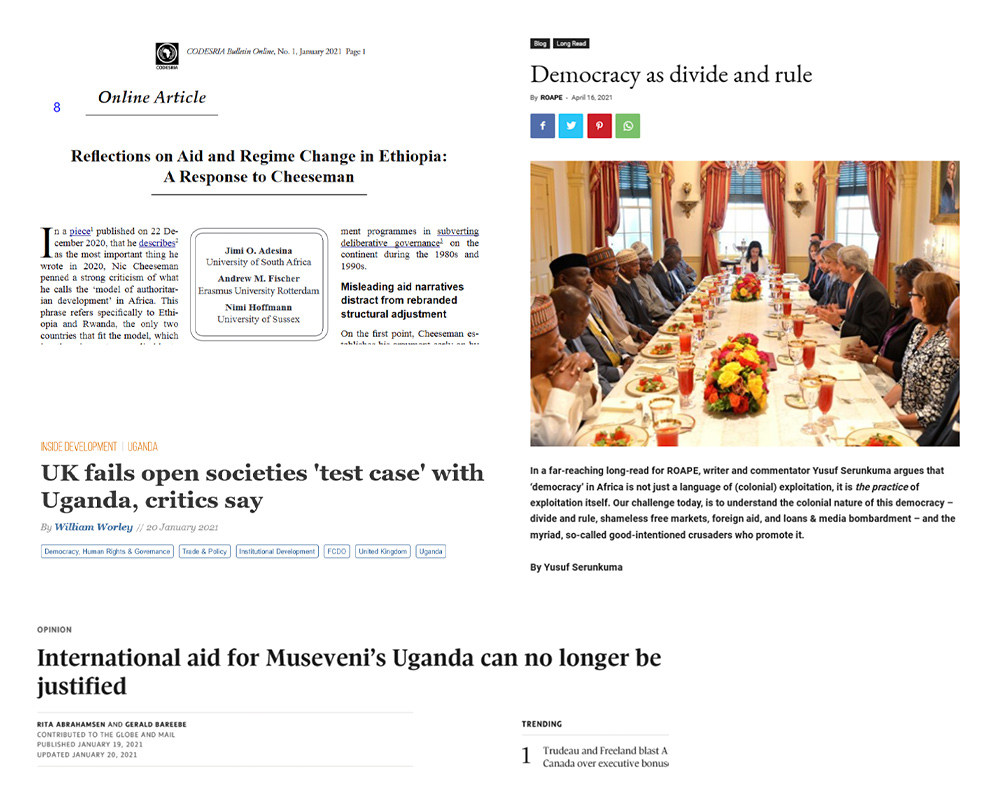 The issue here is one that Serunkuma’s latest pieces clearly help to bring into focus: to what extent (and when, why, how, etc.) do the analyses that come out of part of the expert/commentator/academic/media community reflect the foreign policy positions of their governments (i.e. are thus in a particular way political).
The issue here is one that Serunkuma’s latest pieces clearly help to bring into focus: to what extent (and when, why, how, etc.) do the analyses that come out of part of the expert/commentator/academic/media community reflect the foreign policy positions of their governments (i.e. are thus in a particular way political).
How does this relationship between scholars/journalists and government/policy shape the analyses (i.e. matters of focus, argument, evidence, etc.) and modes of knowledge production?
How does that relationship shape scholarly and media controversies, such as the ones around Rwanda? And in what way does existing scholarship (and power relations etc.) inhibit a more extensive, critical debate about Western foreign policy (and discourses and narratives), vis-a-vis governments and leaders on the continent?
And does, as Serunkuma reminds us, a debate proper about “monsters” in the West not emerge because that debate does not get facilitated and supported (also via book launches and reviews), but rather is sidelined, by mainstream media and scholarship? In short, what are the taboos of Western mainstream scholarship and media and might there be a link to how the “monster” debate has unfolded, in the past and now? We cannot go deeper into this issue now, but note that some of these issues about sections of Western scholarship, scholars and analysts get also discussed, for example, in a recent intervention by Moses Khisa, in some twitter posts earlier this year by Frederick Golooba-Mutebi, Yusuf Serunkuma, Godwin Murunga and Jimi Adesina, and in the Editorial philosophy statement of the Pan African Review, amongst others.
Further then with the racism argument: Racist ideas are not new. For years analysts have lamented the “coup, war, famine syndrome” — that the continent only surfaces into Western news coverage, or into popular books, when it faces one of these catastrophes. As a result, no coherent image of Africa or its people can be narrated outside these categories/tropes – the continent simply does not exist without its wars, famines and monsters. These are not simply justifications for foreign interventions in the continent, but long held racist ideas about Africa’s barbarity.
The book and the fast-mounting debate relate to wider political issues and discourses.
Early European intrusion into the continent was justified, set-up and carried out to rid Africa of its pre-existing barbarity – its natural tendency to chaos and disorder. The cases are too extensive to cover in this piece, so we will limit ourselves to two examples. Algeria was invaded by France in 1830, and engaged in a war of pacification as Algerians fought the invaders for decades. Officially, the country was conquered in 1848 but in reality, there were hardly any years without fighting between 1830 and 1871.
The invasion was conducted – officially – in the name of civilisation and against native barbarity. The outcome was truly monstrous. After almost a century of French occupation, schooling in a largely literate pre-French society had been decimated by 1950, with UNESCO reporting 90 per cent illiteracy among the “natives”. A population of 6 million in 1830 had collapsed to less than 3.5 million in 1852 as millions were forced off the land, and fertile agricultural regions were taken over to cultivate grapes for the export of wine to mainland France. Algerians were labelled “primitive” and unable to appreciate French civilisation, their behaviour pathologised as brutal and monstrous (Frantz Fanon wrote about how this impacted mental health – a process, he described in his medical lexicon, of recerebralising Algerians, literally reshaping their brains and thinking). When Algerians fought back in the 1950s, demanding independence, this was once more regarded as an expression of their primitive nature, and their innately violent character.
The extent of the devastation following the first decades of French occupation led even the pro-imperialist French politician and historian Alexis de Tocqueville to note that colonisation had made Muslim society more barbaric. In other words, the society was already barbaric, and the French had only deepened its savagery.
The language, tools and analyses of these commentators are unreformed and colonial in origin.
The story of European civilisation conquering African barbarism and its associated monsters was common across the decades of colonial occupation and adventure on the continent. Sometimes the language did not always stick to the barbaric script. Take the Congo. Over a period of twenty years, Henry Morton Stanley – the 19th century imperialist adventurer par excellence – helped to establish what became the murderous Belgian empire in the Congo. As Stanley rampaged through the Congo in the 1870s and 1880s, he saw great opportunity for profit and imagined riches everywhere he turned, but the enemy this time was sloth. “In every cordial-faced aborigine whom I meet I see a promise of assistance to me in the redemption of himself from the state of unproductiveness in which he at present lives”. By 1884, Stanley boasted to King Leopold’s court that he had 500 treaties with chiefs and Congolese headmen. The Berlin Conference that was held at the end of that year and into early 1885 divided up Africa among European nations and officially recognised Leopold as the head of the International African Association of the Congo, soon renamed the Congo Free State.
The stated aim of the new Belgian colony – loudly proclaimed by newspapers and embedded writers – was to abolish slavery (a war was going to be fought against Arab slave traders) and to bring civilisation. In the name of this war against barbarism, a regime of utter brutality commenced. The combination of famine, forced labour and systematic violence wiped out millions; according to the historian Adam Hochschild, the population fell from over 20 million in 1891 to 8.5 million in 1911.
Why is this history important? It is our contention that the language of colonialism has remained a determined and fixed feature of mainstream accounts of Africa. Racist imagery of Africa, its barbaric people – who live under a thin veneer of civilisation – remains unchanged, and essentially monstrous. The result of this constant narrative, and its linguistic tools, is to pulverise Africa, to keep its people and politics in a tight hold, and, of course, to justify intervention, provide racist analyses and condescension. For the dominant European narrative, Africans need to be categorised and controlled – this is how it’s done.
To conclude, the debate about these wider and case-specific matters is ongoing, for example in the critical accounts of Wrong’s book and the endorsing reviews. And its continuation is vital. In the meantime, perhaps, the UK press could consider a self-imposed ban on having monster characterisations in its reporting and headlining.
Post-script
An Indian outlet changed the original title of a conversation piece by Roger Southall about Mugabe from a monster-free headline into a with-monster headline.
Original
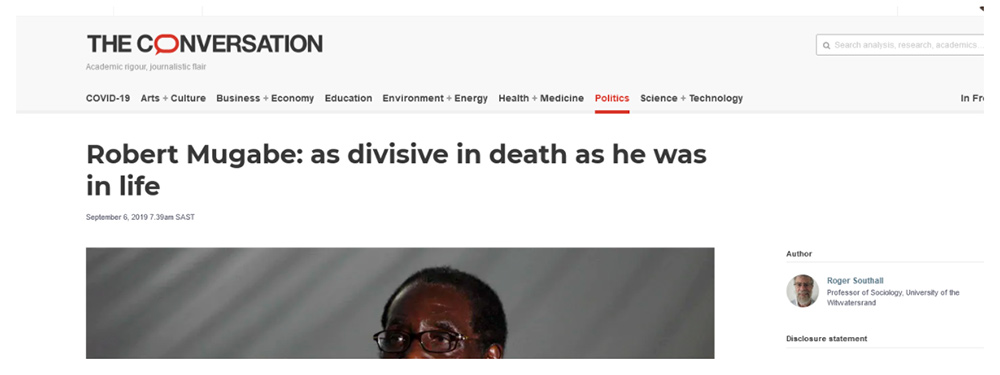 And the headline on the website in India.
And the headline on the website in India.
